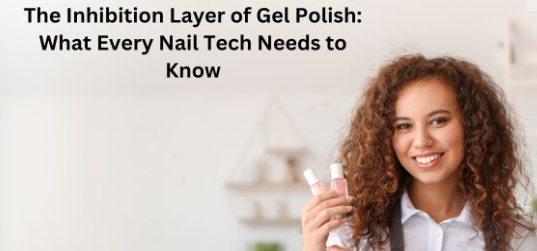The Mysterious Restraining layer of gel nail polish: What every manicurist needs to know
As a manicurist, understanding the science behind your products is essential to delivering the perfect results for your clients. One aspect that often confuses people new to nail polish is the inhibitory layer. This sticky, dispersed layer forms on the surface of the cured gel. We’re here to demystify this phenomenon and teach you how to solve it like a pro.
What is the inhibition layer?
First, let’s define what we’re dealing with. The inhibition layer, also known as the dispersion layer or sticky layer, is a thin film that remains uncured on the surface of the gel polish after curing. This layer forms when the gel polish is exposed to oxygen during curing, preventing the outermost layer’s complete polymerization (hardening).
Why did it form?
The formation of the inhibition layer is a natural result of the curing process. Gel polishing is cured with an ultraviolet (UV) or light-emitting diode (LED) lamp. This triggers a chemical reaction that hardens the liquid gel and forms a solid plasticized film. However, oxygen suppresses this reaction on the surface, leaving behind a thin, dense layer.
The purpose of the inhibition layer
While the suppression layer may initially seem annoying, it serves an essential purpose. This dense layer helps subsequent gel-polished coatings adhere correctly to the curing layer below, ensuring a solid and lasting bond between the layers. Without a suppressor layer, your gel nail polish may not last as long or may come off more easily.
Processing suppression layer
Now that you understand the science behind the suppression layer, it’s time to learn how to deal with it effectively. Here are some suggestions:
Dehydrating and decontaminating: Before applying the first coat of gel nail polish, properly dehydrate and decontaminate the nail’s surface. This step will ensure that the gel adheres perfectly to the deck and provides a solid base for your manicure.
Cover the free edge: When applying the final coat of nail polish, apply the gel to the bottom of the nail, covering the free edge (the tip of the nail). This helps prevent premature fragmentation or lifting at the free edge.
Apply a coat: A high-quality, glossy gel top coat is your best friend when dealing with suppressor layers. The topcoat forms a protective, non-stick shield over your gel polish, sealing in your hard work and ensuring a lasting, perfect finish.
Remember, practice makes perfect! As you gain more experience with gel polishing, dealing with suppressor layers will become second nature. Embrace this aspect of the gel nail polish application process, and you’ll be well on your way to delivering stunning, long-lasting nails that keep your clients returning for more.





